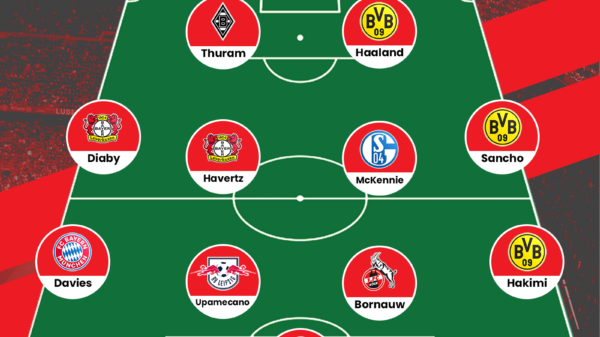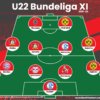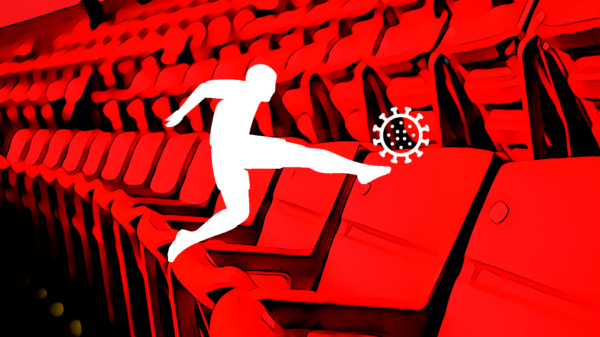Germany underwent Reunification in 1991 following the collapse of the Soviet Union. East and West Germany became one and it was a time of great joy for Germans, especially those who had lived on the Eastern side of the border. With it came reunification for German football, with the members of the East German Oberliga rejoining their Western counterparts. However, at least in this 2012-13 edition of the Bundesliga, there are no teams from what was formerly known as East Germany. So what has contributed to the continued inability of the East German clubs to compete consistently with teams from the West?
During the Nazi era in Germany, the national club competition was known as the Gauliga. Things were still very decentralized and local during this time but many clubs began to become professional and competition began more intense. With the end of World War II and the fall of Nazism came a time of occupation but also the revitalization of club competition and the first formation of central domestic professional leagues in both West and East Germany.
East German Football: The DDR-Oberliga
The East German domestic league was known as the DDR-Oberliga or East German Premier League. It was founded in 1949 and while there were some variations in the rules, it most often consisted of fourteen teams with the bottom two being relegated to the second tier of East German football, the Liga Staffel A or B. The league was intact until 1991 when the Soviet Union collapsed. So with consistent club competition, what kept the teams from reaching the potential of their Western neighbors?
The answer lies in East German society itself. Life in East Germany was harsh, just as it had been in the Soviet Union and other Soviet-occupied territories. The government and networks of secret police, known as the Stasi, governed most of what happened in East Germany. This even applied to football.
The first champions of the DDR-Oberliga were a club named ZSG Horst Zwickau from Zwickau, Saxony. They captured the title dramatically on the last day of the season with a 5-1 rout of Dresden Friedrichstadt. Sounds good, right? Well, what that sentence doesn’t mention is that the Dresden club was refused substitutions by the referee and ended the match with only eight men on the pitch. Shocking actions for a referee. What were his reasons? He was directed by Communist authorities who thought that Dresden Friedrichstadt had not quite been Communist enough. A properly Communist team should win the title, so Zwickau walked off the field champions. Well, ran off the field, away from angry Dresdeners who invaded the pitch after the match.
As a result of this pitch invasion, Dresden Friedrichstadt was dissolved. The city of Dresden needed a new team and that came in the form of Dynamo Dresden. The team was affiliated with the Volkspolizei, the national police force of East Germany. This began a trend that was popular in the Soviet Union at large. Teams became affiliated with government entities and were tools of propaganda and political will. So after Dynamo Dresden won their first DDR-Oberliga title in 1953, this success attracted the attention of the Stasi and their director, Erich Mielke. He noted that Berlin lacked a strong team, so he just took the one from Dresden.
They went on to become Dynamo Berlin but were eventually renamed Berliner Dynamo FC in 1966. With Mielke at the helm, Berliner Dynamo became a dominant force in East German football. They enjoyed modest success during this time but starting in 1979 until 1988, they won ten consecutive DDR-Oberliga titles, becoming the most successful East German club in domestic competition. This was due completely to Mielke’s influence. Intimidation of opposing teams and referees was all too regular during his reign. So the game was corrupt domestically. The true indicator of how East Germany was falling behind the rest of Europe was in continental competition.
Continental Competition: West is Best
While Dynamo Dresden and Berliner Dynamo turned continental competition into an annual tradition in East Germany, neither team was able to make a transition into a truly strong team, often getting no further than the quarter finals of either the European Cup or other competitions. Dynamo Dresden was able to win the Cup Winners’ Cup but that stands as the only success for an East German team in European competition. Meanwhile, Bayern Munich was beginning a string of dominant years in Europe, winning three straight European Cups from 1974-76. Hamburger SV were runners-up in the same competition in 1980 before winning the famous trophy in 1983. West German teams also began to put their stamp on the UEFA Cup, with Borussia Monchengladbach lifting the trophy in 1975 and 1979, with runners-up finishes in 1973 and 1980. That 1980 UEFA Cup Final was an all West German affair, with Eintracht Frankfurt winning that fixture. Bayer Leverkusen won the Cup in 1988. Meanwhile, the winners’ lists for both of these competitions are noticeably devoid of East German clubs.
You might be thinking, so what? Things like this have happened all over Europe. League Championships and Cup titles were handed to clubs favorable to a dictatorial regime. This happened most famously in Spain with Real Madrid enjoying huge success under the dictator at the time, Francisco Franco. Obviously, Spain has overcome these problems, so why hasn’t East Germany? Maybe their league was weaker, so they didn’t perform as well in Europe. But then since the Reunification and the merger of East and West German club football, why haven’t East German teams caught up?
When the Berlin Wall came down, a stream of footballing talent made the exodus west, heading to play for the richer West German teams. Stars for Dresden during the DDR-Oberliga years included Ulf Kirsten and Matthias Sammer, who both followed success and riches away from Saxony to the West, with Kirsten joining Leverkusen and Sammer joining Dortmund. They went on to win Bundesliga titles and contribute to a united German national teams success, but Dresden and East Germany was left in the rearview mirror.
East German Football: Where Do They Go From Here?
Despite these clubs best efforts, the stigma of East Germany still hangs over their heads. Berliner Dynamo FC are playing in the fourth tier of German football currently and have few prospects for possible Bundesliga participation. This story applies to almost all of the teams from the DDR-Oberliga. The only real exception to this rule is Dynamo Dresden, because of the fact that Hertha Berlin, who is geographically in East Germany obviously but was not allowed to compete in the DDR-Oberliga for political reasons. Dresden had a thrilling end to the 2012-13 2. Bundesliga campaign when they finished 16th and were forced to play Vfl Osnabruck in the Relegation Playoff. They lost the away leg 1-0 and had it all to do at home. In the home leg, team captain Cristian Fiel scored a left-footed shot from outside of the area and Idir Ouali completed the comeback with a tap in on 77 minutes. Dresden now are in a position to improve their standing in the German league structure. With Hertha Berlin securing promotion, there will be a team from the capital in the Bundesliga. However, now, as ever, the remnants of the DDR-Oberliga are lagging behind their Western counterparts.
This article was written by Phil Baki. You can follow him on twitter @bakiBalboa
- Talent Radar: Bundesliga 10 Young Players (U-19) to Watch in 2016-17 - September 6, 2016
- Hipster Guide 2016-17: Middlesbrough’s tactics, key players, and emerging talents - August 11, 2016
- Im Herzen Vereint: The Incredible Story of Dynamo Dresden - July 13, 2016


























































